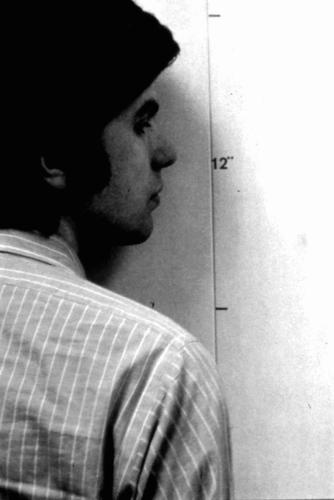Mel Bochner
dal 11/10/2002 al 12/1/2003
Segnalato da
11/10/2002
Mel Bochner
Carnegie Museum, Pittsburgh
Mel Bochner Photographs, 1966-69 reveals the artist's contributions to Conceptualism by highlighting the importance of his photography in the movement's development. For Bochner, photography was well suited to exploring the abstract ideas and systems behind artistic practice, which interested him more than focusing on the representation of objects.

Carnegie Museum of Art features the early photography
of Conceptual art pioneer Mel Bochner
The early photographs of Mel Bochner (b. 1940) will be on
view in Carnegie Museum of Art's Forum Gallery, October 12, 2002-January 12,
2003. Mel Bochner Photographs, 1966-1969 showcases 31 important,
little-known works that demonstrate Bochner's role during the formative
years of the Conceptual art movement.
Bochner, a Pittsburgh native and graduate of Carnegie Mellon University, is
best known for installations and paintings that probe the abstract concept
of measurement. In the late 1960s, Bochner, like other Conceptual artists,
turned away from self-expression, choosing instead to explore organized
systems of thought, such as language and mathematics, through artistic
practices that used minimal aesthetics.
Mel Bochner Photographs, 1966-69 reveals the artist's contributions to
Conceptualism by highlighting the importance of his photography in the
movement's development. For Bochner, photography was well suited to
exploring the abstract ideas and systems behind artistic practice, which
interested him more than focusing on the representation of objects.
Bochner's photographs treat a variety of subjects, investigating a range of
artistic phenomena such as perspective, color, scale, and language. A number
of pieces in the exhibition record Bochner's experimentation working outside
standard photographic formats, including several multi-panel and
large-format works that the artist cut and manipulated. When installed
several inches from a wall, these works produce an effect that blurs the
distinction between two-dimensional media and sculpture.
Some pieces in the exhibition deal with mathematical ideas. 36 Photographs
and 12 Diagrams (1966) depicts an numerical sequence, emphasizing the whole,
as well as showing the incremental changes in its creation. To do this,
Bochner built and photographed a series of stacked wooden blocks,
emphasizing the mathematical principle of the arrangement step-by-step.
Works like Surface Dis/Tension (1968) delve into the depiction of
perspective. Beginning with a photograph of a grid, Bochner soaked the
print and peeled away the image-bearing surace, allowing it to wrinkle while
drying. He then photographed the image of the grid as it appeared on this
crumpled membrane. Next, Bochner made positive and negative prints of the
distorted grid on the same piece of paper, simultaneously revealing the
original perspective as well as its altered form.
Other works probe how presentation affects perception. H-2 (1966-67), for
example, minimizes the difference between sculpture and photography. The
piece is a gelatin silver print of stacked wooden blocks in a cruciform
arrangement, cut in silhouette and mounted on Masonite. When viewed head-on,
the work gives the illusion of depth. Viewed obliquely, the third dimension
disappears. This mutability hints at Bochner's awareness of art's power to
bridge, as well as widen, the gap between object and representation.
According to exhibition curator Scott Rothkopf, "People often think that
Conceptual art is hard to understand, and that it doesn't offer the viewers
a lot visually. Bochner, however, cared very much that his photographs be as
interesting to look at as they are to think about."
Reception
Bochner will be at Carnegie Museum of Art on October 11, 2002, for a
dialogue with exhibition curator Scott Rothkopf. This event, which begins
at 6 p.m. in the Museum of Art Theater, is open to the public and free with
museum admission. A public reception follows.
Publication
The 185-page exhibition catalogue Mel Bochner Photographs, 1966-1969, by
Scott Rothkopf, includes an essay by Elisabeth Sussman and 40 color plates,
as well as 119 black-and-white illustrations. The catalogue, published by
Yale University Press in conjunction with Harvard University Museums, is
available in the Carnegie Museum of Art Store for $35, and copies will be
available for purchase and book signing during the public reception.
Support
Mel Bochner Photographs, 1966-69 was organized by Scott Rohtkopf for the
Harvard University Art Museums. Support for the exhibition was provided by
Suzanne F. Cohen, Deborah and Martin Hale, Keith and Katherine Sachs, George
David, Constance R. Caplan, Arthur M. Cohen, The Fifth Floor Foundation, Mr.
and Mrs. D. Ronald Daniel, and the John M. Rosenfield Teaching Exhibition
Fund. Major support for the exhibition program at Carnegie Museum of Art is
provided by The Heinz Endowments and the Pennsylvania Council on the Arts.
Image: Mel Bochner
American, b. 1940
Actual Size (Face), 1968
Gelatin silver print
22 x 14 1/2 in.
Carnegie Museum of Art
Located at 4400 Forbes Avenue in the Oakland section of Pittsburgh and
founded by industrialist and philanthropist Andrew Carnegie in 1895,
Carnegie Museum of Art is nationally and internationally recognized for its
distinguished collection of American and European works from the sixteenth
century to the present. The Heinz Architectural Center, part of Carnegie
Museum of Art, is dedicated to the collection, study, and exhibition of
architectural drawings and models.
For more information about Carnegie
Museum of Art, call 412.622.3131 or visit our web site.
Carnegie Museum
4400 Forbes Avenue, PA 15213-4080
Pittsburgh



